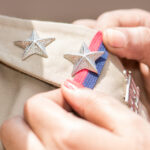Independence Day 2023: Dos and don’ts to follow while hoisting India’s tricolour national flag
Dos and don’ts to follow while hoisting India’s tricolour national flag : As India gears up to mark its 77th Independence Day, here’s all you need to know about the dos and don’ts to follow while hoisting the tricolour national flag
This year, India will be celebrating its 77th Independence Day on August 15 when the Indian National Flag (also known as the Tiranga as it is a tricolour flag consisting of three horizontal stripes of saffron, white and green), will be hoisted at several schools, colleges, offices and public places across the country.
The flag’s design and colours have deep historical and cultural meanings and it holds immense significance as the national symbol of India, representing the country’s unity, diversity and aspirations where the saffron colour on the top represents courage, sacrifice, the spirit of renunciation and the dedication and commitment of the people towards the country’s well-being.

On the other hand, the white colour stripe in the middle symbolises truth, peace, purity and reflects the hope for harmony and unity among India’s diverse communities while the green colour stripe at the bottom stands for growth, fertility, prosperity and represents the vibrant agricultural landscape of India as well as the country’s faith in sustainable development.
The white stripe in the middle features a navy blue Ashoka Chakra at the centre which is a 24-spoke wheel inspired by the Lion Capital of Ashoka, an ancient sculpture and this Ashoka Chakra represents the eternal cycle of life and death, signifying the righteousness that should guide the nation’s actions.
The Bureau of Indian Standards (BIS) and the Flag Code of India have set the guidelines for hoisting and using the Indian National Flag and these guidelines are meant to ensure that the flag is treated with the utmost respect and dignity, including that the flag should always be hoisted briskly and lowered slowly, should never touch the ground or water nor be used as clothing or be displayed in a damaged or defaced state.
Do’s:
1. Section 2 of the new code accepts the right of all private citizens to fly the tricolour on their premises.
2. A member of public, a private organisation or an educational institution may hoist or display the national flag on all days and occasions, ceremonial or otherwise consistent with the dignity and honour of tricolour.
3. The tricolour may be hoisted in educational institutions such as schools, colleges, sports camps, scout camps, etc to inspire respect for the national flag.
4. An oath of allegiance has been included in the tricolour hoisting in schools.
5. When hoisting the national flag, do it with a sense of respect and dignity, recognizing the importance of the symbol.
6. The flag should be hoisted on important national and cultural occasions such as Independence Day, Republic Day and other significant events.
7. The saffron band should be at the top when the flag is hoisted and the flag should be flown with the green at the bottom.
8. When not in use, fold the flag neatly in a triangular shape resembling a tricolor and store it in a respectful manner.
9. Follow the appropriate protocol for hoisting the flag. It should be hoisted briskly and lowered slowly. It should also be saluted while hoisting and lowering.
10. The national flag should always be hoisted in a position of prominence. It should ideally be the highest flag in a group of flags.
11. Those hoisting the flag should be dressed in clean and respectful attire, preferably formal wear.
12. The size of the flag and the material used for it should be of appropriate quality and standard.
Don’ts:
1. The tricolour cannot be used for communal gains, drapery or clothes, should not be used for decoration purposes nor be used as a tablecloth, handkerchief or any disposable item.
2. The tricolour should be flown from sunrise to sunset, irrespective of the weather, as far as possible.
3. Do not show disrespect to the flag, such as stepping on it, allowing it to touch the ground or the floor intentionally or using it in a way that undermines its dignity like letting it trail in the water. It can’t be draped over the hood, top and sides or back of vehicles, trains, boats or aircraft.
4. No other flag or bunting can be placed higher than the tricolour.
5. No object, including flowers or garlands or emblems, can be placed on or above the tricolour.
6. The tricolour can’t be used as a festoon, a rosette or a bunting.
7. Do not hoist a damaged or faded flag as it is considered disrespectful to the national symbol.
8. The flag should not be flown at half-mast on occasions other than those designated by the government. It is a mark of respect for national leaders and dignitaries.
9. Do not deface or mutilate the flag by adding any slogans, words, or designs to it.
10. The flag should not be used for private or personal purposes unless it’s in the form of a lapel pin or a small flag displayed on vehicles on national occasions.
11. The flag should not be hoisted or displayed at night, unless it is illuminated.
12. When not in use, the flag should not be crumpled or stored haphazardly. It should be folded neatly and stored properly.
Hoisting the Indian National Flag is a significant and solemn act, often done on national holidays such as Independence Day (August 15) and Republic Day (January 26), as well as on state and local occasions and is an important and respectful activity that should be conducted with proper decorum and respect for the national symbol. It is a symbol that represents the rich history, diversity and aspirations of the Indian people.













